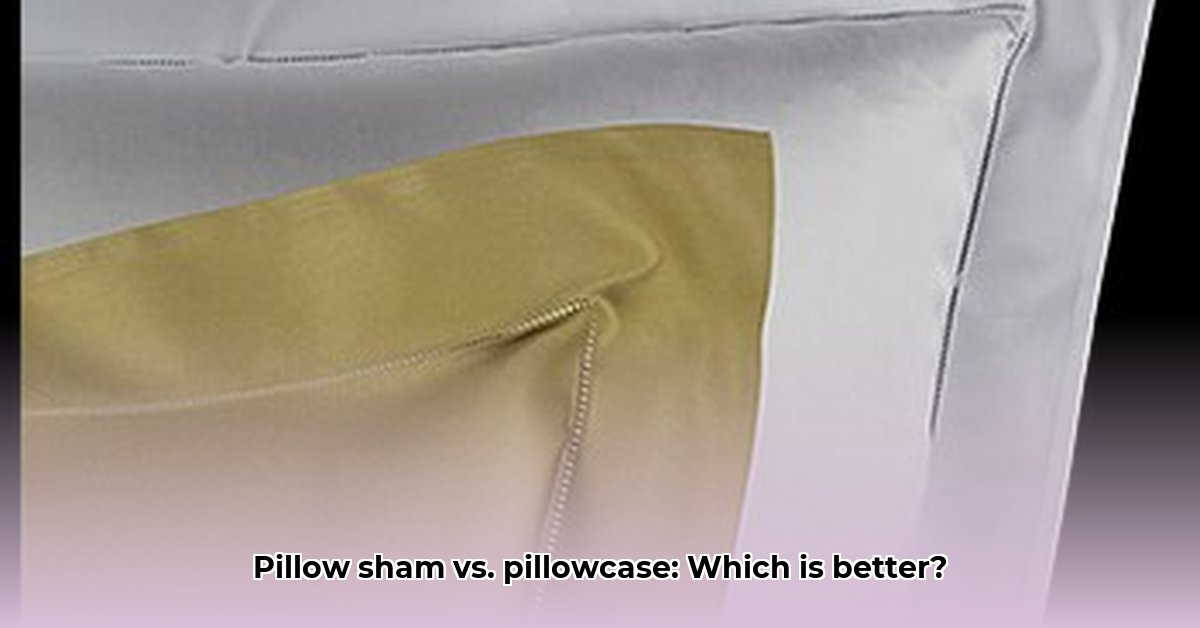“`markdown
Upgrade Your Sleep: Pillow Sham vs Pillowcase Guide
Picking the perfect pillows and bedding can be tricky! This guide will clear up the confusion between pillow shams and pillowcases. We’ll show you the differences – from how they look and feel to how you care for them – so you can create a bedroom that’s both stylish and comfy. Whether you’re after a cozy, comfy sleep or a gorgeous bedroom upgrade, we’ve got you covered. We’ll walk you through everything, from choosing the right fabrics and sizes to keeping your pillows fresh and looking great. For more on pillow arrangement, check out this guide on king-size bed pillow arrangement. Let’s dive in!
Pillow Sham vs Pillowcase: A Guide to Better Sleep Quality
Ready to give your bedroom – and your sleep – a serious upgrade? Let’s talk about pillow shams and pillowcases. They might look similar at first glance, but these bedding buddies have distinct roles to play in creating a comfy and stylish sleep sanctuary. This guide will help you understand the differences, explore decorative options and choose the best options for you.
Materials and Construction: The Fabric of the Matter
Think of pillowcases as your pillow’s everyday protectors. They’re the unsung champions of hygiene, shielding your pillow from the nightly accumulation of skin cells, hair oils, and other natural elements. You’ll typically find them made from comfortable, practical materials like cotton (soft, breathable, and easy to care for), linen (durable with a cool, crisp feel), microfiber (smooth and wrinkle-resistant), or blends of these. Their design is usually straightforward – a simple opening, often with an overlapping flap, to easily slip the pillow inside and keep it securely contained.
Pillow shams, on the other hand, are the stylish statement pieces of your bedding ensemble. They’re less focused on nightly protection and more about adding a touch of glamour, color, and personality to your sleep space. You’ll often find them in a wider variety of fabrics – think plush velvet for a luxurious touch, shimmering silk for elegance, intricately patterned brocade, or richly textured linen for a more relaxed look. They’re often more elaborate in their construction, too, frequently featuring hidden zippers, button closures, or elegant envelope closures that give them a more tailored, polished look. Many also include decorative flanges (a flat border around the edge), piping, or embroidery.
Functionality and Purpose: More Than Meets the Eye
The main difference between a sham and a case really boils down to their primary function. Pillowcases are all about practicality – keeping your pillow clean, fresh, and extending its lifespan. They act as a protective barrier between you and your pillow, shielding it from sweat, oil, makeup residue, and dead skin cells. This helps prevent the buildup of bacteria and allergens, keeping your pillow fresh and hygienic, which is beneficial for your skin, your respiratory health, and the longevity of your pillow.
Pillow shams, however, are primarily decorative. They’re the finishing touch, the visual flourish that completes your bed’s aesthetic. While you could technically sleep on a sham, it isn’t generally recommended for a few reasons. Many shams feature embellishments like embroidery, beads, or textured stitching that could be uncomfortable against your skin during sleep. The fabrics used might also not be as breathable or as easily washable as those used for standard pillowcases, potentially leading to a less restful night and more difficult cleaning. Shams are meant to be removed before sleep, preserving their decorative elements and keeping them fresh for show.
Sizing and Variations: Finding the Perfect Fit for Your Pillows
Both pillowcases and shams come in standard sizes to match your bedding and pillow dimensions. However, shams typically offer a wider range of sizes and shapes, especially with the popular addition of Euro shams. These larger, square shams are designed for decorative pillows, often used to prop up against the headboard or add height and visual interest to your bed arrangement. Boudoir shams, smaller rectangular options, provide another decorative accent.
Here’s a handy size guide:
| Size | Pillowcase Dimensions (approx.) | Pillow Sham Dimensions (approx.) | Common Pillow Type |
|---|---|---|---|
| Standard | 20″ x 26″ | 20″ x 26″ | Standard Bed Pillow |
| Queen | 20″ x 30″ | 20″ x 30″ | Queen Bed Pillow |
| King | 20″ x 36″ | 20″ x 36″ | King Bed Pillow |
| Euro | N/A | 26″ x 26″ | Euro Pillow (Square Decorative) |
| Boudoir | N/A | 12″ x 16″ | Small Rectangular Decorative Pillow |
Care and Maintenance: Keeping Your Bedding Fresh and Fabulous
Proper care and maintenance are essential for keeping your bedding fresh, clean, and looking its best. Pillowcases, due to their direct and nightly contact with your skin, should generally be laundered at least weekly, or even more frequently if you have oily skin or use heavy skincare products at night. Pillow shams, since they’re primarily decorative and not slept on, can typically be washed less frequently – perhaps every 2-4 weeks, unless you’ve spilled something on them or notice they’re becoming dusty.
Always check the care labels on both pillowcases and shams for specific washing and drying instructions – some delicate fabrics like silk or heavily embellished materials may require special handling, such as hand washing or dry cleaning. Washing in cold water and using a gentle detergent can help preserve the color and integrity of the fabrics. Proper care will ensure your bedding stays looking and feeling its best for years to come.
Budget Considerations: Balancing Style and Savings
Generally, pillowcases are more budget-friendly than shams, as they’re made from simpler materials and have a more basic construction. Simple cotton, microfiber, or polyester pillowcases are widely available at affordable prices. However, the price of shams can vary greatly depending on the fabric, construction, and embellishments. Luxury fabrics like silk, velvet, or linen, along with intricate detailing like embroidery or piping, will naturally command a higher price tag.
Consider your budget and prioritize what’s most important to you – practical hygiene and comfort, or elevated style and visual appeal. It’s possible to find attractive and durable options at various price points, so do your research and compare prices before making a purchase.
Buying Guide: Making the Right Choice for You
Choosing between a sham and a case really depends on your individual needs, preferences, and lifestyle. Let’s walk through a simple decision process to help you make the best choice for your bedroom:
Step-by-Step Decision Process:
- Assess Your Priorities: Are you primarily concerned with hygiene, comfort, and pillow protection? Prioritize pillowcases made from soft, breathable, and easy-to-care-for materials. Are you aiming to create a more luxurious, visually appealing, and coordinated bedroom aesthetic? Invest in shams to complement your duvet cover, bedspread, or other decorative elements (while still using protective pillowcases underneath!).
- Establish a Budget: Determine how much you’re comfortable spending on bedding. This will help you narrow down your options and avoid overspending. Remember to factor in the cost of both pillowcases and shams if you plan to use both.
- Select Your Fabrics Wisely: Choose materials that complement your existing bedding, coordinate with your bedroom décor, and consider your personal preferences for feel, texture, and maintenance requirements. Think about the season, too – lighter, cooler fabrics like linen or cotton percale are ideal for summer, while warmer, cozier fabrics like flannel or velvet are perfect for winter.
- Measure Your Pillows Accurately: Before purchasing any pillowcases or shams, measure your pillows carefully to ensure a proper fit. An ill-fitting pillowcase or sham can look sloppy and detract from the overall aesthetic of your bed.
- Consider Your Lifestyle: Do you have allergies or sensitive skin? Opt for hypoallergenic and breathable materials like silk, bamboo, or Tencel. Do you have pets that sleep on the bed? Choose durable, easy-to-clean fabrics that can withstand frequent washing.
The Verdict: The Power of a Perfectly Coordinated Pair
Ultimately, the best approach is often to use both a pillowcase and a pillow sham in combination. The pillowcase keeps your pillow clean, fresh, and protected, prolonging its lifespan and promoting better hygiene. The sham adds that extra touch of style, sophistication, and visual interest to your bedding, transforming your bedroom into a more inviting and personalized sleep sanctuary. It’s a win-win for both practicality and aesthetics, allowing you to enjoy the best of both worlds – a clean, comfortable pillow and a bedroom that reflects your personal style.
How Often Should I Wash My Pillow Shams Based on Material?
Key Takeaways:
- Pillowcases should be washed weekly (or more often) for optimal hygiene and skin health.
- How often should I wash my pillow shams based on material? The answer depends on the material, their use (decorative vs. sleeping), and your personal habits. Monthly washing is generally sufficient for purely decorative shams that are not slept on.
- Pillows themselves (the inserts) need cleaning every six months to a year, or as recommended by the manufacturer, varying by fill material (down, feathers, synthetic).
- Glass Backsplash: Ideas For a Stylish Kitchen Update - December 2, 2025
- Glass On Tile: A Stylish Kitchen Backsplash Option - December 1, 2025
- Glass Tiles for Kitchen: Style and Durability Tips - November 30, 2025










